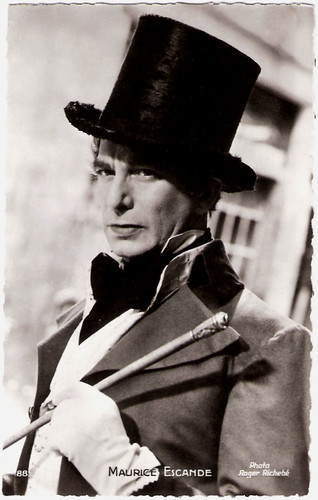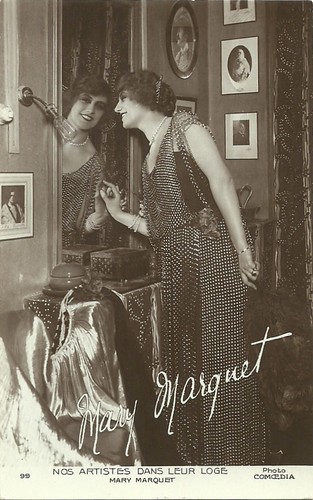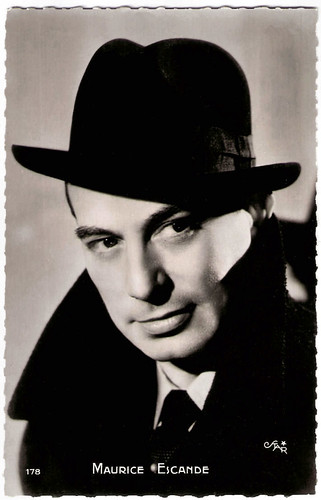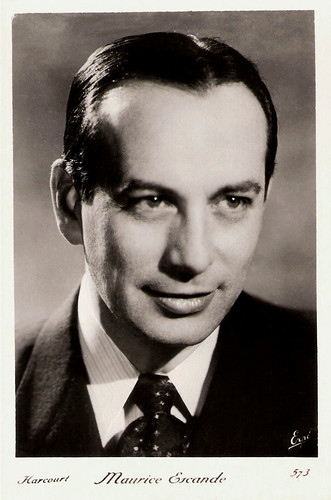Maurice Escande (1892-1973) was one of the main actors and directors of the Comédie-Française, the oldest and most illustrious theatre company in France. He also had an intense career as a film actor, as a matinée idol in the silent era, but in particular as the elegant and distinctive aristocrat in French sound cinema between the 1930s and 1950s.

French postcard by Collection Chantal, Paris. no. 88.

French postcard by Editions Chantal, Paris, no. 88. Photo: Roger Richebé. Might be a publicity still for the Honoré De Balzac adaptation Le père Goriot (Robert Vernay, 1945), in which Escande played the Count de Restaud, husband of one of Goriot's daughters, Anastasie. The title role was played by Pierre Larquey.
Maurice René Escande was born in Paris in 1892. As the son of a diplomat, he spent a large part of his youth in the Far East before returning to France. He pursued his studies at the Lycée Saint-Louis, even if he was less than passionate about school. During his adolescence, he saw a stage play at the Théâtre de l’Odéon and decided to become a stage actor.
He followed courses by Denis d’Inès and had his modest debut at the Théâtre des Arts in 'The Brothers Karamazoff', with Jacques Copeau, Charles Dullin and Louis Jouvet. Afterwards, he applied for the Conservatoire and won first prize for comedy and a second prize for tragedy in 1912. While a pupil of the class of Raphaël Duflos, he interrupted his studies to leave for the military front during the First World War.
After being demobilised he played at the Odéon, under the direction of Paul Gavault, and continued his studies at the Conservatoire where he finished with a first prize in 1918. He immediately joined the Comédie-Française as aPpensionnaire (paid actor) and had his debut there as Hippolyte in the classic play 'Phèdre' by Jean Racine, with Paul Mounet and Madeleine Roch.
After playing some 90 parts, he refused to become a Sociétaire (regular member) and left the Comédie in 1925 for the Boulevard Theatre. On-demand of actress Cécile Sorel, he returned in 1934 and accepted to become Sociétaire until 1956, with an interval between 1946 and 1948. All in all, Escande belonged to the troupe from 1918 to 1970 and played 178 roles at the Comédie-Française, plus some 16 roles elsewhere. From the late 1930s on, he also directed several plays at the Comédie and elsewhere, mostly the classic repertory of Jean Racine, Pierre Corneille and Pierre de Marivaux.
After being promoted to doyen, Escande took the reins of the Comédie-Française in 1960, when it was in full crisis. After ten years of administration, he appeased the tensions and opened up the repertory to authors like Eugène Ionesco, Jacques Audiberti and Georges Shéhadé, and the younger generation (Antoine Bourseiller, Coline Serreau). Subsequently, he became Administrateur Générale Honoraire (honorary general director) until the end of his life. Escande’s lessons formed famous future actors such as Georges Marchal, Marthe Mercader, Dany Robin, Micheline Boudet, Jacques Charon, Claude Piéplu and Michel Bouquet.

French postcard in the Nos artistes dans leur loge series, no. 138. Photo: Comoedia.

Mary Marquet. French postcard in the Nos artistes dans leur loge series by Editions La Fayette, no. 99. Photo: Comoedia.
Already in the late 1910s, the young and handsome Maurice Escande debuted in the cinema. He played the jeune premier in short silent films such as Un vol étrange/A Strange Flight (Henri Desfontaines, 1917) with Andrée Pascal and Simone (Camille de Morlhon, 1918) with Simone Genevois.
Already in his third film, the serial L’Essor/The Boom (Charles Burguet, 1921), he played a lead as Max, the boyfriend of Suzanne (Suzanne Grandais). He is kidnapped by a baron who desires Suzanne, but the courageous woman sets out to find her lost love. During filming in the summer of 1920, Grandais and the cameraman were killed in a car accident, which forced Burguet to change the story.
Escande continued to act in silent films as Mademoiselle la Seiglière (André Antoine, 1921), the Alphonse Daudet adaptation Fromont jeune et Risler ainé (Henry Krauss, 1921) in which Escande played Fromont jeune opposite Jean Angelo, and La ferme du choquart/The Choquart farm (Jean Kemm, 1922) with Mary Marquet as a beautiful, scheming innkeeper’s daughter, who commits adultery with a marquis (Escande).
Escande then played in the First World War drama Les deux soldats/The Two Soldiers (Jean Hervé, 1923) with Germaine Rouer, and the Émile Zola adaptation Nantas (1925) starring and directed by Donatien.
For some months in 1921-1922, Maurice Escande was married to his co-star in La ferme du choquart (1922), the great tragedy actress Mary Marquet. However, Escande was homosexual. He and Marquet would continue to act together long after their separation and remained close friends, but Escande never remarried and preferred the company of men. After Nantas (1925), he quit acting in film, until sound cinema was well-established in France.

French postcard by A.N., Paris, no. 55. Photo: Henri Manuel. Caption: Escande de la Comédie Française.

French postcard by A.N., Paris, no. 1056. Photo: Intran Studio.
Because of his aristocratic presence and his perfect diction, Maurice Escande was a much-in-demand actor for film adaptations of stage plays by Yves Mirande, Marcel Pagnol and Sacha Guitry.
Escande also excelled in his performances of historical characters such as the Duke of Buckingham in Les trois mousquetaires/The Three Musketeers (Henri Diamant-Berger, 1932-1933), Giovanni Borgia, Duke of Gandia in Lucrèce Borgia/Lucrezia Borgia (Abel Gance, 1935), the lord of the village in La Marseillaise/The Marseillaise (Jean Renoir, 1937), General von Neipperg in Madame Sans-Gêne (Roger Richebé, 1941), Louis XIV in Échec au roy/The King's failure (Jean-Paul Paulin, 1945), the Prince de Condé in Le capitan/The Captain (Robert Vernay, 1946), Cardinal de Rohan in L’affaire du collier de la reine/Queen's Necklace (Marcel L’Herbier, 1945), Klemens von Metternich in Le diable boiteux/The Lame Devil (Sacha Guitry, 1948) and Louis XV in Napoléon/Napoleon (Sacha Guitry, 1954).
Maurice Escande acted in over 50 features and though never with top billing, he still proved to be a precious counterpart to actresses such as Marie Bell, Arletty, Danielle Darrieux, Elvire Popesco, Viviane Romance, Odette Joyeux, Michèle Morgan, Micheline Presle and Brigitte Bardot.
However Guy Bellinger writes on IMDb: "But the adjective 'prestigious' cannot apply to his film career, rich in terms of quantity (70 titles) but much less in terms of quality. Too few great names of French cinema used him, and when they did, they tended to hire Escande for their lesser efforts like Marcel Pagnol for Le gendre de Monsieur Poirier (1933) or Jean Grémillon for L'étrange Mme X (1951). And what a lot of cheesy titles in his filmography signed by patented rubbishy filmmakers as Wulschleger, Caron, Vallée, Hugon, Tavano, Couzinet, and Jayet! Just to boil the pot for sure. (...) Anyway, Maurice Escande's great presence and noble bearing always added value to the films he appeared in, whatever their quality was. (...) he was one of the great names of French theatre who brought their talent to the seventh art, enhancing a film when it was good and making it bearable when it was a bomb."
In 1966 Escande played himself, that is the Chair of the Jury of the Comédie-Française, in the wartime comedy Martin Soldat/Kiss Me General (Michel Deville, 1966). His last part was that of a director in Claude Berri’s autobiographical Le Cinéma de Papa (1970). After a shining career on the French stage, Maurice Escande died of cancer in Paris in 1973. He lies buried in the cemetery of Montrouge in the region of Paris.

French postcard by Editions P.I., Paris, no. 178. Photo: Star.

French postcard by EPC, no. 126. Photo: Simson.

French postcard by Erpé, Paris, no. 573. Photo: Harcourt.
Sources: Pascal Donald (Ciné-Artistes) (French), Guy Bellinger (IMDb), Bibliothèque du Film (French), Wikipedia (French and English) and IMDb.
This post was last updated on 20 February 2024.

French postcard by Collection Chantal, Paris. no. 88.

French postcard by Editions Chantal, Paris, no. 88. Photo: Roger Richebé. Might be a publicity still for the Honoré De Balzac adaptation Le père Goriot (Robert Vernay, 1945), in which Escande played the Count de Restaud, husband of one of Goriot's daughters, Anastasie. The title role was played by Pierre Larquey.
Comédie-Française
Maurice René Escande was born in Paris in 1892. As the son of a diplomat, he spent a large part of his youth in the Far East before returning to France. He pursued his studies at the Lycée Saint-Louis, even if he was less than passionate about school. During his adolescence, he saw a stage play at the Théâtre de l’Odéon and decided to become a stage actor.
He followed courses by Denis d’Inès and had his modest debut at the Théâtre des Arts in 'The Brothers Karamazoff', with Jacques Copeau, Charles Dullin and Louis Jouvet. Afterwards, he applied for the Conservatoire and won first prize for comedy and a second prize for tragedy in 1912. While a pupil of the class of Raphaël Duflos, he interrupted his studies to leave for the military front during the First World War.
After being demobilised he played at the Odéon, under the direction of Paul Gavault, and continued his studies at the Conservatoire where he finished with a first prize in 1918. He immediately joined the Comédie-Française as aPpensionnaire (paid actor) and had his debut there as Hippolyte in the classic play 'Phèdre' by Jean Racine, with Paul Mounet and Madeleine Roch.
After playing some 90 parts, he refused to become a Sociétaire (regular member) and left the Comédie in 1925 for the Boulevard Theatre. On-demand of actress Cécile Sorel, he returned in 1934 and accepted to become Sociétaire until 1956, with an interval between 1946 and 1948. All in all, Escande belonged to the troupe from 1918 to 1970 and played 178 roles at the Comédie-Française, plus some 16 roles elsewhere. From the late 1930s on, he also directed several plays at the Comédie and elsewhere, mostly the classic repertory of Jean Racine, Pierre Corneille and Pierre de Marivaux.
After being promoted to doyen, Escande took the reins of the Comédie-Française in 1960, when it was in full crisis. After ten years of administration, he appeased the tensions and opened up the repertory to authors like Eugène Ionesco, Jacques Audiberti and Georges Shéhadé, and the younger generation (Antoine Bourseiller, Coline Serreau). Subsequently, he became Administrateur Générale Honoraire (honorary general director) until the end of his life. Escande’s lessons formed famous future actors such as Georges Marchal, Marthe Mercader, Dany Robin, Micheline Boudet, Jacques Charon, Claude Piéplu and Michel Bouquet.

French postcard in the Nos artistes dans leur loge series, no. 138. Photo: Comoedia.

Mary Marquet. French postcard in the Nos artistes dans leur loge series by Editions La Fayette, no. 99. Photo: Comoedia.
Homosexual
Already in the late 1910s, the young and handsome Maurice Escande debuted in the cinema. He played the jeune premier in short silent films such as Un vol étrange/A Strange Flight (Henri Desfontaines, 1917) with Andrée Pascal and Simone (Camille de Morlhon, 1918) with Simone Genevois.
Already in his third film, the serial L’Essor/The Boom (Charles Burguet, 1921), he played a lead as Max, the boyfriend of Suzanne (Suzanne Grandais). He is kidnapped by a baron who desires Suzanne, but the courageous woman sets out to find her lost love. During filming in the summer of 1920, Grandais and the cameraman were killed in a car accident, which forced Burguet to change the story.
Escande continued to act in silent films as Mademoiselle la Seiglière (André Antoine, 1921), the Alphonse Daudet adaptation Fromont jeune et Risler ainé (Henry Krauss, 1921) in which Escande played Fromont jeune opposite Jean Angelo, and La ferme du choquart/The Choquart farm (Jean Kemm, 1922) with Mary Marquet as a beautiful, scheming innkeeper’s daughter, who commits adultery with a marquis (Escande).
Escande then played in the First World War drama Les deux soldats/The Two Soldiers (Jean Hervé, 1923) with Germaine Rouer, and the Émile Zola adaptation Nantas (1925) starring and directed by Donatien.
For some months in 1921-1922, Maurice Escande was married to his co-star in La ferme du choquart (1922), the great tragedy actress Mary Marquet. However, Escande was homosexual. He and Marquet would continue to act together long after their separation and remained close friends, but Escande never remarried and preferred the company of men. After Nantas (1925), he quit acting in film, until sound cinema was well-established in France.

French postcard by A.N., Paris, no. 55. Photo: Henri Manuel. Caption: Escande de la Comédie Française.

French postcard by A.N., Paris, no. 1056. Photo: Intran Studio.
Great presence and noble bearing
Because of his aristocratic presence and his perfect diction, Maurice Escande was a much-in-demand actor for film adaptations of stage plays by Yves Mirande, Marcel Pagnol and Sacha Guitry.
Escande also excelled in his performances of historical characters such as the Duke of Buckingham in Les trois mousquetaires/The Three Musketeers (Henri Diamant-Berger, 1932-1933), Giovanni Borgia, Duke of Gandia in Lucrèce Borgia/Lucrezia Borgia (Abel Gance, 1935), the lord of the village in La Marseillaise/The Marseillaise (Jean Renoir, 1937), General von Neipperg in Madame Sans-Gêne (Roger Richebé, 1941), Louis XIV in Échec au roy/The King's failure (Jean-Paul Paulin, 1945), the Prince de Condé in Le capitan/The Captain (Robert Vernay, 1946), Cardinal de Rohan in L’affaire du collier de la reine/Queen's Necklace (Marcel L’Herbier, 1945), Klemens von Metternich in Le diable boiteux/The Lame Devil (Sacha Guitry, 1948) and Louis XV in Napoléon/Napoleon (Sacha Guitry, 1954).
Maurice Escande acted in over 50 features and though never with top billing, he still proved to be a precious counterpart to actresses such as Marie Bell, Arletty, Danielle Darrieux, Elvire Popesco, Viviane Romance, Odette Joyeux, Michèle Morgan, Micheline Presle and Brigitte Bardot.
However Guy Bellinger writes on IMDb: "But the adjective 'prestigious' cannot apply to his film career, rich in terms of quantity (70 titles) but much less in terms of quality. Too few great names of French cinema used him, and when they did, they tended to hire Escande for their lesser efforts like Marcel Pagnol for Le gendre de Monsieur Poirier (1933) or Jean Grémillon for L'étrange Mme X (1951). And what a lot of cheesy titles in his filmography signed by patented rubbishy filmmakers as Wulschleger, Caron, Vallée, Hugon, Tavano, Couzinet, and Jayet! Just to boil the pot for sure. (...) Anyway, Maurice Escande's great presence and noble bearing always added value to the films he appeared in, whatever their quality was. (...) he was one of the great names of French theatre who brought their talent to the seventh art, enhancing a film when it was good and making it bearable when it was a bomb."
In 1966 Escande played himself, that is the Chair of the Jury of the Comédie-Française, in the wartime comedy Martin Soldat/Kiss Me General (Michel Deville, 1966). His last part was that of a director in Claude Berri’s autobiographical Le Cinéma de Papa (1970). After a shining career on the French stage, Maurice Escande died of cancer in Paris in 1973. He lies buried in the cemetery of Montrouge in the region of Paris.

French postcard by Editions P.I., Paris, no. 178. Photo: Star.

French postcard by EPC, no. 126. Photo: Simson.

French postcard by Erpé, Paris, no. 573. Photo: Harcourt.
Sources: Pascal Donald (Ciné-Artistes) (French), Guy Bellinger (IMDb), Bibliothèque du Film (French), Wikipedia (French and English) and IMDb.
This post was last updated on 20 February 2024.
No comments:
Post a Comment